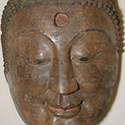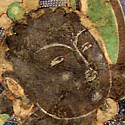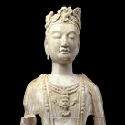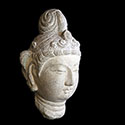|
|
| Show All 7 Results (Text Only) |
|
| Buddhist Cave Temple Sculpture |
|
| Victoria and Albert Museum
|
The Central Asian tradition of building such complexes was been practiced for centuries, primarily with Imperial sponsorship in the Northern regions, where Buddhism first took hold. The very act of creating these vast monuments, hollowed out from rock faces and decorated so lavishly within, was considered an act of 'piety' resulting in the accrual of merit, which in Buddhism is accumulated as a result of good deeds, acts or thoughts. This merit is then carried over to later in life or to a person's next birth. The sculptures and paintings also functioned as an important focus for worship and as symbolic links between the worldly and heavenly realms. People would have travelled great distances to see them and to worship and make offerings before them.
Go to Museum Resource: http://www.vam.ac.uk/content/articles/c/chinese-buddhist-cave-temple-sculpture/ | |
|
|
| Cave as Canvas: Hidden Images of Worship Along the Ancient Silk Routes |
|
| National Museum of Asian Art, Smithsonian Institution
|
Buddhist Cave Temples in Chinese Central Asia. Buddhism reached Chinese Central Asia (modern Xinjiang) from India around the first century A.D., brought by missionaries via the ancient Silk Routes. By the third century A.D., this new religion was flourishing in all the oasis kingdoms in the Tarim Basin (the Taklamakan Desert), also known as eastern Turkestan. As the Buddhist religion took hold and piety increased, the Indian tradition of excavating caves to serve as Buddhist sanctuaries proliferated in this region. In many of the Central Asian states, monasteries and temples were hewn out of the cliffs in secluded river valleys. With the patronage of local rulers, the elite, and wealthy merchants, these institutions gradually became major Buddhist centers. They continued to grow and prosper until the advent of Islam. Today, such Buddhist rock-cut cave complexes are some of the finest, if little known, monuments preserved in Chinese Central Asia.
Go to Museum Resource: https://archive.asia.si.edu/exhibitions/online/cave/default.htm | |
|
|
| China: Dawn of a Golden Age, 200–750 AD |
|
| The Metropolitan Museum of Art
|
Publication of the exhibit that explores exceptional works of art from forty-six institutions in the People's Republic of China. Includes references to works of art in the Metropolitan's permanent collection, relevant literary references, maps, and details about how certain objects were crafted. See also exhibition publication.
Go to Museum Resource: https://www.metmuseum.org/exhibitions/listings/2004/china-dawn-of-a-golden-age | |
|
|
| Monks and Merchants: Silk Road Treasures from Northwest China, Gansu and Ningxia, 4th-7th Century |
|
| Asia Society
|
Features more than 35 objects organized into the following topics: 1) Heavenly Horses; 2) Nomadic Rulers; 3) Buddhism and China; 4) Buddhist Cave Temples; 5) Bodhisattvas; 6) Monks; 7) Merchants and Currencies; 8) The Tang Dynasty. Each topic has overview text, and each object is accompanied by short descriptive text. An additional topic on the Silk Road itself gives extensive background information on the geographical, historical, religious, and cultural context of the Silk Road.
Go to Museum Resource: http://sites.asiasociety.org/arts/monksandmerchants/index.html | |
|
|
| Return of the Buddha: The Qingzhou Discoveries |
|
| National Museum of Asian Art, Smithsonian Institution
|
"In 1996 a chance discovery in Qingzhou ... in the northeastern province of Shangdong, brought to light an incredible buried treasure. Workers leveling a school sports field stumbled upon a pit brimming with hundreds of broken, but otherwise well-preserved, sixth-century Buddhist statues." Content organized into five topics -- Discovery (about the excavation), Color, Styles, Gallery (featuring 9 sculptures), and Resources (links to related websites).
Go to Museum Resource: https://archive.asia.si.edu/exhibitions/online/returnofbuddha/base.html | |
|
|
| Tianlongshan Caves Project |
|
| Center for the Art of East Asia, University of Chicago
|
The Buddhist cave temples of Tianlongshan (Heavenly Dragon Mountain) are located in the mountains thirty-six kilometers southwest of Taiyuan city in the central part of Shanxi province. They exist today in a damaged state with so many of the sculptures now missing, that visitors to the caves cannot imagine how they looked in the past. Many of the sculptures from the caves are now in museums around the world. However, though the sculptures may be preserved and displayed, visitors to museums cannot understand them in their original historical, spatial, and religious contexts. For these reasons the Center for the Art of East Asia in the Department of Art History at the University of Chicago initiated the Tianlongshan Caves Project in 2013 to pursue research and digital imaging of the caves and their sculptures. The Project seeks to record and archive the sculptures and to compile data that can identify the fragments and their places of origin. In carrying this out, the Project aims to foster better understanding of the sculptural art, the history, and the meaning of the Tianlongshan Caves through creation of this website and through an exhibition of the results of the Project based on digital information.
Go to Museum Resource: https://tls.uchicago.edu/ | |
|
|
| Xiangtangshan Caves Project |
|
| Center for the Art of East Asia, University of Chicago
|
The Northern Qi dynasty (550-577) produced a large body of important works of art during its brief existence. A central achievement of the period is the complex of Buddhist caves of Xiangtangshan and their stone sculptures and engraved inscriptions, created near the Northern Qi capital with official sponsorship. Unfortunately, the cave shrines are now severely damaged and the sculptures and fragments of carvings from the cave sites scattered around the world. The Xiangtangshan Project has sought to acquire a better understanding the caves in broader narratives of the art and visual culture of the Northern Qi period and of the history of Buddhism in China. Its components and objectives were to 1) to conduct collaborative research, 2) to create a digital database of images and information on the caves and sculptures of Xiangtangshan, and 3) to present of the results of research with digital reconstruction of the caves, an exhibition, and international conferences. This website serves as a database of the project's results and a resource for future research. See also: supplemental website with Buddhist sutras and dedicatory inscriptions.
Go to Museum Resource: https://xts.uchicago.edu/ | |
|
|
|
| Show All 7 Results (Text Only) |








